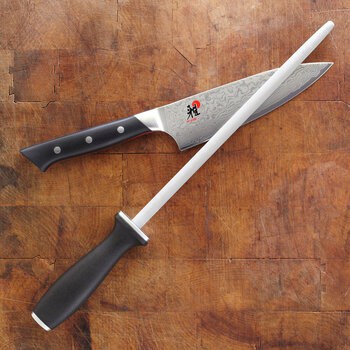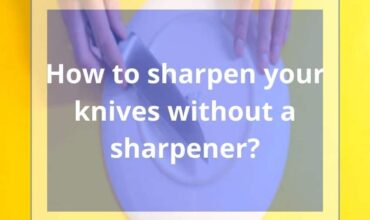What is more irritating than having a dull steak knife or chef’s knife that can barely slice a piece of meat? Almost nothing!
A lot of beginner chefs and housewives do believe that knife honing and knife sharpening are the exact same processes. but the fact is they are totally different things.
Sharpening tools mainly include: manual knife sharpener, electric knife sharpener. while honing tools mainly include honing rods.
In this handy guide, I will be telling you everything you need to know about honing knives and I will teach you how to hone your knife like a pro!

Why do you need to hone your kitchen knife?
in the daily meal prep., you will be slicing chicken, onions, or tomatoes on a cutting board.
these daily tasks get you pushing your knife steel edge out of line. This can cause one side to fold over instead of standing straight, resulting in a bent knife’s edge.
Even if it appears hard and solid, the knife steel still can be bent, particularly the knife edge.
The primary purpose of honing a knife is to restore a misaligned edge. This is just preserving an existing sharp edge.
When you hone a sharp knife’s blade, you polish the uneven surface of the edge. this will decrease friction and help the knife to cut more effectively.
How often should you hone your kitchen knife?
Never try to over-hone a dull knife. Many skilled cooks, do advise honing a sharp knife after every usage.
But that will only damage the blade edge. So we recommend honing your sharp knife after three uses at the very least. This will help to keep the kitchen knife high performance. (whether it is a serrated knife or straight knife).
Honing your knives more than this might damage your kitchen knife instead of protecting it. But it cannot hurt, so if you have the time, hone after each use.
Read more, Best Knives’ Oil and Lubricant Review
How to adjust the right angle for honing?
honing your serrated edge or straight edge will damage the knife edge immediately. so here is how to properly adjust the right angle to hone a kitchen knife.
Steps
Step 1: Fold Over and crumple the top right corner of a piece of paper down towards the base and align with the left side, creating a 45-degree angle.
Step 2: Fold the 45-degree angle next to the left-hand edge again, for a total of 22.5 degrees, then do it again for a total of 11.25 degrees.
Step 3: Unfold it once, and the midpoint between the 22.5 and 11.25 angles is nearly perfect for your honing angle. To highlight the angle, draw a line with a pen or trim the paper to this angle.
now I will show you how to hone your kitchen knife using various honing tools.
How to hone a knife with ceramic rod?
Steps
Step 1: Hold and adjust the blade edge.
- Maintain a vertical position for the top end of the ceramic honing rod.
- To reduce the possibility of slippage, place a wet towel on a flat surface.
- With your dominant hand, grasp the handle. Place the knife’s edge on the rod’s spine.
- Lift until the angle that matches the one shown on the paper.
Step 2: Start honing the knife’s edge.
- Dump the paper and hone it down immediately once you have got the right angle.
- Stroke the knife’s edge from heel to tip, from top to bottom on the ceramic rod, switching sides between each stroke.
- Three to four strokes will do the job.
Read more , The Best Ceramic Folding Knife /Pocket Knife Review
How to hone your knives with a honing steel rod?
Steps
Step 1: Position and adjust the honing angle
- The vertical grip is the most comfortable for most novices.
- Place the tip of the steel into the cutting board on a flat surface while holding the sharpening steel handle.
- Set the heel of the knife’s edge at a 15-20 degree angle against the tip of the sharpening rod.
Step 2: Slide the knife edge along the side of the honing steel
- Using only light pressure, stroke the knife edge down the steel, using the entire length of the steel.
- Pull across the whole length of the knife blade, keeping a consistent angle.
Step 3: Hone the other side
- Place the knife’s heel against the opposite side of the steel at a 15- to a 20-degree angle.
- Slide the knife blade all over the steel till the knife’s tip hits the steel’s tip.
- Repeat on both sides until the dull blade is honed—about 8 strokes per side is standard.
Also check, Best High-End Kitchen Knife Sets
How to hone a knife with a whetstone?
Steps
Step 1: Check your knfe
- Slide the knife’s blade gently against the back of your fingernail. If it sticks, your kitchen knife or pocket knife has a nice edge. If it glides off, then you have a dull knife.
- Consider how you utilize your knives. If you consistently place them to the testing, they will need regular honing to keep their edge.
- Consider whether your knife has been through any recent damage. Some blades lose their sharpness fast when they come into contact with another harsh piece of metal. Or when they go into the dishwasher.
Step 2: Choose the proper grit of sharpening stone
- One of the fundamental guidelines is that a very dull blade should be sharpened first using the coarsest gritstone.
- However, if you have recently sharpened your knives, you may skip into the medium and fine grits.
Also read , How to Hone Your Knife?
Step 3: Prepare the sharpening Stone
Whetstone
- If you are going to use a wet stone, make sure it is totally covered in water and soaking for at least 45 minutes.
Oil stone
- Bring aside the oil you want to use to cover the sharpening stone.
- It is preferable to use oil that is labeled as sharpening or honing oil.
- These are usually made using non-petroleum materials and have additives that help your blade last longer.
- Make no attempt to grease your sharpening stone with cooking oils.
Diamond stone
- Because diamond stones are the single form of whetstone that could be utilized dry, no preparation is usually required.
- However, if desired, some water can be added to coat the surface.
Step 4: Prepare your working station
- Position your sharpening stone on top of a wet towel on a flat surface.
- Make sure the side you wish to use first is facing up if it is a double-sided stone.
- Make sure space is not too small since you will need a lot of room to move around while running the blade across the Stone.
Step 5: Practice holding the knife at the right angle
- Hold the kitchen knife in front of you at a 90-degree angle, with the knife’s blade perpendicular to the table’s surface.
- The blade sitting level on the tabletop, while indicatinng 0 degrees.
- Rotate the knife halfway toward the table surface from its upright position, creating a 45-degree angle.
- Split the angle in half again, creating a 22.5-degree angle. That is near enough to the necessary 20 degrees to start honing.
- To gain a sense of what it would feel like while striking the Stone, practice swinging your arm back and forth at a 20-degree angle
Also check, What are the Benefits of Oysters?
Step 6: Hone one side
- Slide the knife’s blade slowly down the Stone, stroking it at an angle as you go.
- Draw the knife blade whole edge against the Stone, ensuring that it is sharpened equally from heel to tip.
- If the Stone begins to feel dry, wet it down or apply more oil.
- Repeat this method till the first side of the sharp blade is honed.
Step 7: Hone the other side
- Repeat the same on the back face of the knife.
- Be careful when completing the final details on the blade. Since both honed edges might lead to an injury if you are reckless.
Why do honing steels get dirty?
Most honing steels are slightly magnetic. When you use honing steel on your knife’s edge. It can remove small metal particles.
Such metal particles might accumulate in the pores of the steel and clog them over time.
This can cause the steel to lose its functionality as the pores fill with small metal dust. And the rod becomes sleeker.
People frequently believe that their rod is simply wearing out and that they need to replace it. In fact, the flatness of the rod is simply due to their lack of cleaning it after each usage.
How to clean your honing rod?
Giving your honing steel a fast wipe after each use is the most practical way to maintain it clean.
This does not have to be a time-consuming process. Simply wipe the honing steel clean with a dry towel after each usage.
This will polish away a lot of those small metal particles. You are allowing your steel to last much longer before requiring deep cleaning.
How to use vinegar to clean your honing rod?
Your honing steel may eventually get too blocked to be removed by simply wiping it with a dry towel. Because most honing rods are slightly magnetic, particles will physically attach to the rod and collect over time.
When you have reached that point, a dry cloth will not help. You will need something more powerful.
But do not worry. There is a simple and inexpensive solution to remove those metal particles from your honing steel.
Using a moist cloth with a bit of vinegar sometimes for a more thorough clean is a helpful idea. If you rub this along the rod, it should clean it better than just wiping it with a dry cloth.
Read more , How to shuck oysters without an oyster knife?
Can a honing rod wear off?
If you notice that no matter how much work, you put into wiping your honing steel. And it still does not seem to be very functional. You may have to accept the situation that you need to replace it.
To see if your honing steel is worn out, swipe the grooves on the steel rod with your fingernail. if they feel smooth after cleaning, you may need to replace them.
Another technique is to use the top of a small knife blade, such as a paring knife, like a scraper. Insert the tip of the rod into one of the rod grooves and slide it down the groove.
If it continues in the same groove throughout the entire length of the rod, your steel is most likely still usable. Yet, if it comes out, your rod is most likely worn out and no longer functional.
How to store your honing rod properly?
To keep your honing steel in good condition, follow these two simple actions.
- Sustain the state of your honing rod by keeping it dry.
- Keep your honing rod apart from your knives.
You must maintain your honing rod dry at all times, or it will rust.
Even stainless steel will rust over time. Rust may be formed using only three elements: oxygen, iron, and water. If you clean your honing steel with water, avoid leaving it wet and instead wipe it down dry.
Since your honing steel is somewhat magnetic, you will need to store it aside from anything else metallic. To avoid interfering with the rod’s magnetism in the long run. And to avoid accumulating additional metal particles in the grooves by being kept in the wrong place.





